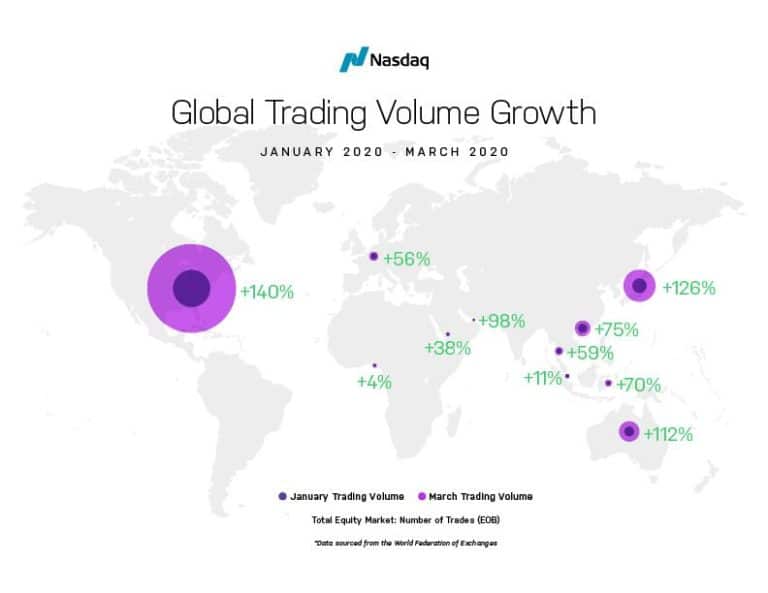Nasdaq’s Market Technology business is responsible for delivering technology and services across the transaction lifecycle to investment banks, brokers, clearinghouses, central securities depositories, regulators and marketplaces – both inside and outside of capital markets. The mission-critical solutions power everything from trading and risk management to market integrity monitoring, clearing and settlement for 120+ market infrastructure organizations and 170+ market participants in over 50 countries.
Given the criticality of the role Nasdaq technology plays, we sat down with Lars Ottersgård, EVP and Head of Market Technology, to discuss the impact of COVID-19 and extreme volatility on technology and the greater market ecosystem.
Q.) How is COVID-19 affecting your client base?
 This is an incredibly unique situation that has essentially impacted the entire global market ecosystem. For all of us, we are firstly concerned with the safety and health of our families, friends, colleagues and ourselves. That comes first. But we’re also tasked with making sure the lights stay on at the markets worldwide. That’s a huge responsibility, but one we have spent time preparing for.
This is an incredibly unique situation that has essentially impacted the entire global market ecosystem. For all of us, we are firstly concerned with the safety and health of our families, friends, colleagues and ourselves. That comes first. But we’re also tasked with making sure the lights stay on at the markets worldwide. That’s a huge responsibility, but one we have spent time preparing for.
My team and I talk daily with our clients worldwide. And I’m very proud when I hear during nearly every meeting that these market operators have strong, resilient business continuity measures in place, and are supporting their local economies by maintaining their operations as they uniquely can.
Of course the COVID-19 pandemic has caused our clients to adjust their operations and perhaps re-think how they interact with their ecosystem, just like we have, but I’ve also been pleasantly surprised to see such a diverse industry being able to manage and keep the world’s markets moving forward.
Q.) How are your systems impacted by the current environment?
We take our role as both a strategic partner and mission-critical technology provider to the industry seriously. We have 120+ customers, where the vast majority are relying on our trading systems to be operational at all times. We also have a large number of clients that are trusting our technology to keep toxic order flow from entering the market and actively manage risk. Or that clearing and settlement is happening on time with proper checks in store. And making sure our clients are able to maintain a fair, orderly and transparent marketplace with continuous monitoring to sustain integrity, even in these unprecedented times. It is a massive responsibility that we cannot take lightly.
While I can acknowledge that some latency is expected in downstream systems given the unprecedented situation, our technology has largely proceeded without major hiccups impacting our clients.
I think that our clients benefit a lot from the reality that we operate our 28 marketplaces with the same technology that they use. We expend an enormous amount of time and resources preparing for extraordinary situations and truly have a robust framework in place to manage eventualities related to a number of crisis scenarios, including pandemics and extreme market conditions.
Q.) How to do you prepare for this type of situation to help ensure a resilient, operational environment?
Market resiliency is a journey not necessarily a moment in time based on a stressful situation. We are laser-focused on the capacity, performance and reliability of our systems and have built a multi-year operational excellence program to ensure that both Nasdaq owned and operated entities, and our client community, can weather any storm.
As a rule, we generally ensure we have at least 2x the capacity of the highest volume trading day. This has been critical in the last few weeks, where in one of our US markets, we saw a single market reach aggregated peaks of more than 60 billion messages each day. A lot of our clients are also seeing massive peaks in volume, and it is critical that we design and build with headway in mind.
Aside from capacity, testing early and often is critical. For our clients we provide necessary operations support 24/7/365 with testing, tuning, and ample support to handle market volatility; however, very importantly, we are not using this time to tweak our software, but rather to evaluate hardware and software set-ups to proactively flag any issues that arise, and address them head-on. Right now, to help manage the COVID-19 environment, we have 40+ engineers and their teams monitoring all of the markets we support across their entire tech stacks.
Within our normal testing program, we spend 40+ weekends of the year regularly testing our systems and disaster recovery processes and procedures. This is critical both for our Nasdaq entities, but also the clients that rely on us. Additionally, because our technology supports 100+ venues including our own, we are able to take the lessons learned by our internal markets and apply them to the external venues we support, and vice versa. This way we are continually exercising a robust feedback loop between our own markets and our clients to ensure that the entire capital markets ecosystem can function in a secure and reliable way, even under extreme duress.
Q.) How are you helping your clients cope?
Our primary concern is ensuring our client community remains up and running at all times. Not just now, because we are amidst a highly volatile market, but 24x7x365. Over the last few weeks, we have been working with our clients proactively on a series of ‘health checks’ to ensure parameters are fine-tuned, there are no hiccups with upstream and downstream systems or any configuration changes that could cause an issue with the massive volumes we are seeing.
We are doing this not only on the trading side of our business, but across all areas, and are also in the midst of working with our sell-side compliance clients to ensure they too are set up for success, and can properly monitor in such a high-volume environment. We continue to encourage positive, proactive dialogue and a consultative approach to tuning our solutions and each firm’s tech stack overall.
Q.) What are some of the things you’re most happy to have accomplished over the first quarter amidst a truly chaotic market environment?
On a lighter note, we have numerous markets projects around the world continuing to move forward. We have celebrated several successful client go-lives in the past few months including Jamaica Stock Exchange launching our matching and surveillance technology to strengthen its market, SIX going live with Nasdaq’s Index Calculator, to consolidate its comprehensive index business on one platform, and Dubai Financial Markets’ go live with new trading, clearing and surveillance technology, which was its largest ever technology upgrade. We’ve also signed a deal with a new alternative trading system (ATS) in the US. And we’ve continued to enhance our offerings for the sell-side to better monitor for market manipulation, including our new data discovery capabilities, which we launched in January.
We also continue to see tremendous innovation power and creativity in capital markets and beyond. A great example of this is the announcement of our partnership with Skytra, Airbus’ new entity that is creating a family of new indices and an MTF for airline derivatives to reimagine risk management for the aviation and airline industry.
So, yes, it’s been an incredibly intense time for all of us. But there’s also been plenty of bright spots along the way, and I’m optimistic that the world’s markets will continue playing an integral part in the health, and recovery efforts, of the global economy.
SOURCE: Nasdaq MarketInsite






